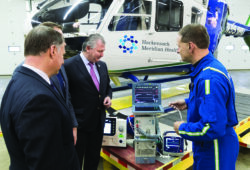In addition to his private practice, Jim Youssef, M.D., oversees an active research department whose work has been published in more than 25 peer-reviewed publications. An outspoken advocate for innovation and the use of technology in spine surgery, he also holds 13 spine-related patents, eight of which are commercially available.
The Source recently talked with Youssef about his groundbreaking work in spine surgery, what other hospitals can learn from his achievements and his insights on the spine device market and better patient outcomes.
What are your program’s unique strengths that lead to such positive outcomes?
We’re very patient-centric and are driven by quality, patient-reported outcomes and reproducibility. We have identified the metrics that we strive to achieve, such as quality-adjusted life years and reducing readmissions, and we continually monitor those indicators. We work closely not only with the hospital, but also with the payers and suppliers on things such as procedural pricing to move toward greater transparency and more emphasis on value-based care. At the end of the day, what sets us apart is that everyone is fully aligned. From the staff in my office and the OR to the physical therapists, case managers and floor nurses—we all collaborate to achieve the same goal.
One of the biggest complaints from physicians and supply chain managers is over implant pricing, specifically, how to determine if supplier pricing is fair. What advice do you have for resolving this?
We can put the cost of implants in buckets and have a range that is palatable to everyone, but that’s a dead-end street, because there’s going to be a ceiling and there’s going to be a floor. Supply chain managers who are looking at pricing should step back and analyze what a procedure costs, soup to nuts. To make that analysis, we need evidence-based data and guidelines. When we all start working on the same page, then we can minimize frustrating negotiations.
What role does technology play in achieving better results? And, in your opinion, what technology is worth investing in?
There’s a lot of emerging technology in spine surgery to help with guidance, screw placement, reduction in blood loss—the list goes on. A clear reimbursement strategy has yet to emerge on these advancements, but that doesn’t mean hospitals shouldn’t invest in them. They should invest, and a good place to start is in technology that enables minimally invasive surgery and reduces tissue trauma. Then, perhaps they could consider a system that can provide intraoperative neuromonitoring. Hospitals should also look into technology that reduces radiation and confirms accuracy of screw position and placement. They also might want to invest in technology that facilitates better communication and real-time feedback in the OR. All of these can help improve and promote efficiencies, reduce variation in care, improve accuracy, reduce complications, and provide a platform by which surgical procedures are reproducible, or performed in a more consistent manner from surgeon to surgeon.
“Identify a champion surgeon who is willing to take on a leadership role. Align the hospital with that surgeon to remove variation of care and standardize costs of physician preference items and procedural pricing …”
You’re not just a fellowship-trained spine surgeon, but you’re also an innovator in spine surgery technology. When did that career avenue start for you, and how does your focus on improving the technology influence patient outcomes?
My background is not in engineering—I studied genetics before going to medical school. But I’ve always been interested in improving products and systems, and I’m always looking for ways to improve new technologies. As surgeons, we’re the ones actually using the products on patients. We shouldn’t be complacent about technology that doesn’t work the way we want; we should try to improve it, which can have widespread benefits.
What kinds of challenges are you most concerned about related to spine surgery? What stands in the way of being able to provide the best possible outcomes for your patients?
The price of spinal implants continues to rise and, as a private practitioner focused on providing a valuable service, that poses big challenges in terms of reimbursement and cost containment. These challenges are going to limit exposure to technology that could help lead to better outcomes.
It can also be difficult for hospitals to attain and sustain a quality service line in high-cost specialties such as spine. Except at facilities with high volume and reproducibility, these specialties are going to migrate to bigger centers, creating a backlog for accessing care. We need to be willing to improve the
delivery of highly specialized care and find ways to reduce these backlogs without compromising quality.
I’m actually working right now with Catholic Health Initiatives, Mercy Regional Medical Center’s national sponsor, to figure that out. Doctors have egos and think their way is best. That’s why you have to analyze what the data says about performance. Once you know that, you can drill down on how to improve it.
Then, identify a champion surgeon who is willing to take on a leadership role. Align the hospital with that surgeon to remove variation of care, standardize costs of physician preference items and procedural pricing, and market the service line to both consumers and referring physicians.
Where do you see the spine implant market in five years? Is there promising new technology on the horizon, and what influence, if any, do you expect aging baby boomers will have on the market?
Spine care is very complex. Unlike orthopedics, we have not even come close to mastering appropriate treatment, so I believe innovation through technology and collaboration will continue to increase. In five years, I predict minimally invasive surgery will be the norm, and we’ll be treating more deformity because of the aging population.
Reimbursement is going to continue to get hit hard because spine procedures are costly and the morbidity rate is high. Lower reimbursements could lead to fewer new doctors wanting to specialize in spine. It may also result in more employed physicians, who unfortunately tend to have less drive to participate in the innovation and improvement of product lines.
That said, I’ve also been reinvigorated by the technology at our disposal, the collaboration with hospitals to improve patient care and the advantages we’re giving to patients in their elderly years. We’re all living longer, so if we can improve quality, that’s really exciting. An 84-year-old patient recently said to me that I gave him his life back—that’s priceless. As long as I feel like I’m providing benefits to patients, I’m very encouraged about the future.
Share Email





